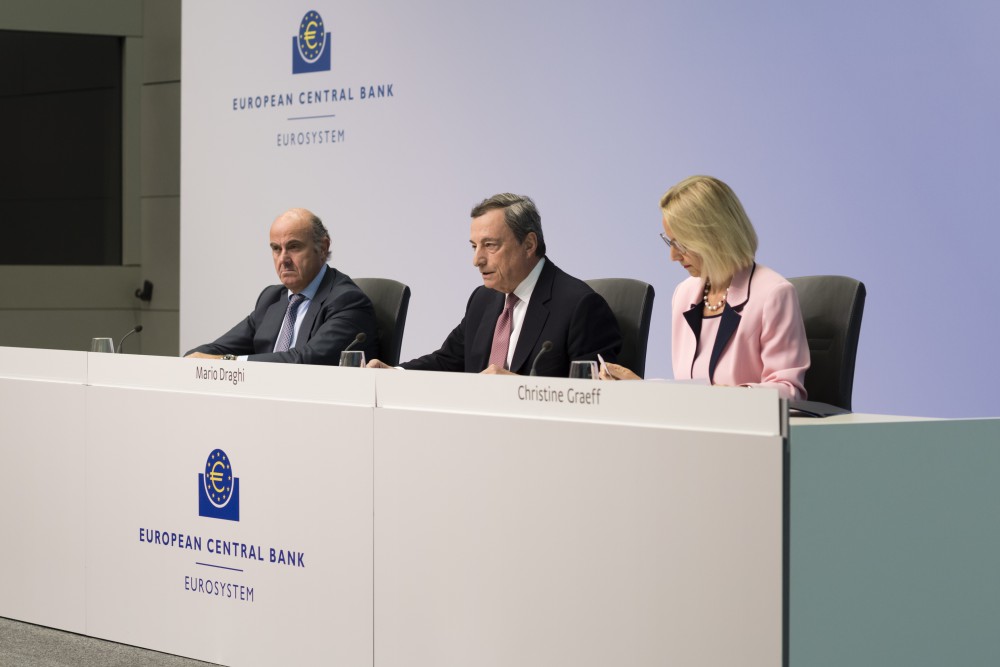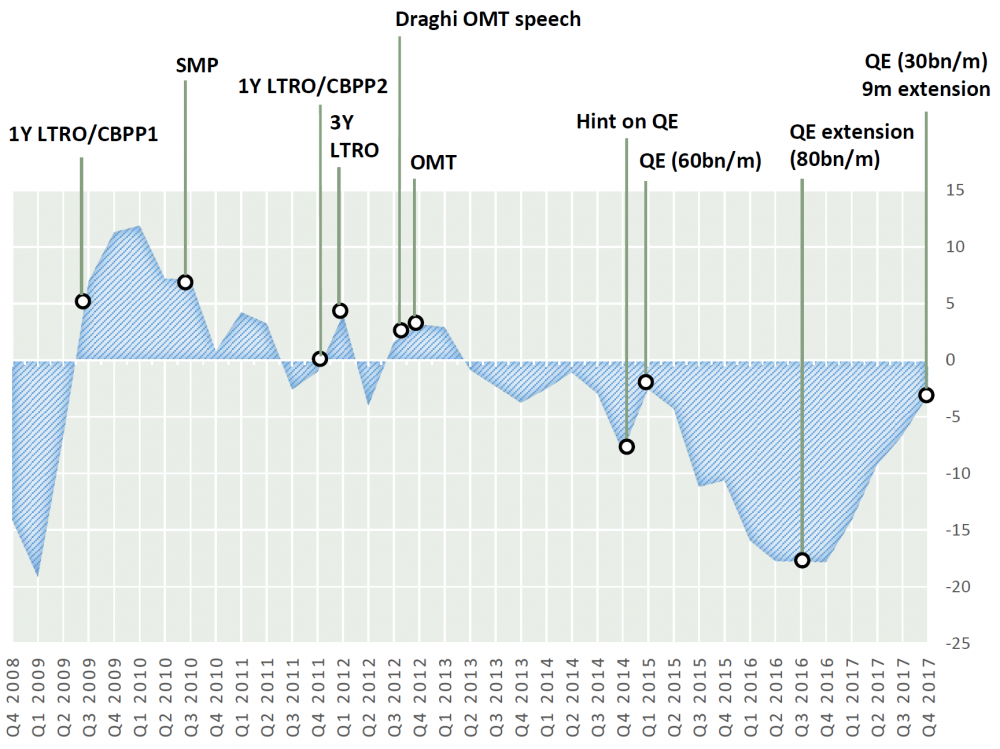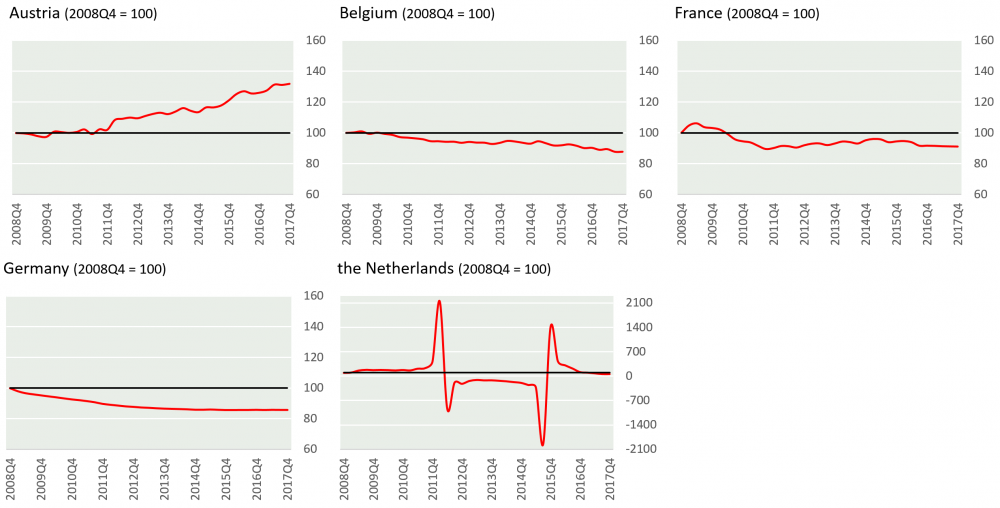Europese Centrale Bank maakt ons rijker en ongelijker?
- ElienMeuleman

© Europese Unie 2018 - Europese Centrale Bank
Vermogensongelijkheid kan niet worden toegeschreven aan de acties van de Europese centrale bank (ECB). Dat blijkt uit recent scriptieonderzoek aan de UGent.
September 2008: de financiële crisis
Exact 10 jaar geleden kwam België in het middelpunt te staan van de zwaarste financiële crisis sinds de Grote Depressie van de jaren 30. De oorzaken van de crisis werden de voorbije jaren veelvuldig geanalyseerd en maken ondertussen deel uit van het standaard handboek van elke economiestudent. Ook al ontstond de crisis op de Amerikaanse huizenmarkt (en vooral de markt voor afgeleide producten), een onaangename bijwerking van zo’n financiële crisis is dat deze ook een weerslag heeft op de reële economie. Hierbij werd Europa het zwaarst getroffen met de Eurocrisis van 2012 als hoogtepunt.
De reactie van de ECB
In een poging om het tij te keren heeft de ECB uitzonderlijke maatregelen genomen. Enerzijds heeft ze enorm soepele financiering condities gecreëerd door haar voornaamste instrument van monetaire politiek, de monetaire beleidsrente, op 0% te zetten. Op die manier tracht ze de geldmarktrente te beïnvloeden wat op zijn beurt een impact heeft op aandelen- en obligatiemarkten, hypotheekrentes en de rente op spaarboekjes. Anderzijds heeft de ECB ook een resem van onconventionele maatregelen in het leven geroepen. De belangrijkste is ongetwijfeld het aankoopprogramma van activa (APP) met als doel aan kwantitatieve versoepeling (“quantitative easing” of afgekort QE) te doen. Zo kocht de ECB bijvoorbeeld massaal overheidsobligaties op om de risicopremie te comprimeren zodat overheden zich opnieuw aan normale markttarieven konden financieren. Dat laatste is niet alleen belangrijk voor de rol van overheidsinvesteringen in economische relanceplannen, maar ook om de schulden uit het verleden te kunnen terugbetalen.
Toenemende ongelijkheid
Het is opvallend hoe er tijdens het voorbije decennium met meer aandacht werd gekeken naar het monetair beleid dan pakweg in de jaren voor de crisis. Hetzelfde geldt ook voor de bezorgdheden rond toenemende ongelijkheid in onze samenleving. Het is dan ook niet verwonderlijk dat beleidsmakers zich de vraag zijn beginnen stellen of er een verband bestaat tussen monetair beleid en ongelijkheid. De wetenschap blijft ons het antwoord schuldig. Er bestaat wel een consensus dat zonder deze monetaire beleidspolitiek, zo goed als iedereen slechter af zou zijn geweest. Maar heeft het monetair beleid ook een herverdeling van rijkdom teweeggebracht? Bij een herverdelingsbeleid denken we in de eerste plaats aan de wisselwerking tussen fiscaal en sociaal beleid. Bijvoorbeeld, het belastingstelsel in de meeste Europese landen beoogt duidelijke herverdelingseffecten waarbij de rijken worden geacht een grotere inspanning te leveren. De herverdelingseffecten van monetair beleid zijn echter veel minder voor de hand liggend. Het is dan ook het onderwerp van het scriptieonderzoek van Bart De Clercq, student Economie aan de UGent, geworden.
Impact van monetair beleid op vermogensongelijkheid?
Het beantwoorden van deze vraag stelt onmiddellijk twee problemen: 1) hoe meet je monetaire schokken op een moment dat de monetaire beleidsrente stabiel op 0% wordt gehouden? 2) hoe kan je de rijkdom van gezinnen in kaart brengen als er geen vermogensregister bestaat binnen de Eurozone?
Om het eerste probleem op te lossen hebben de onderzoekers een model gebruikt dat rekening houdt met de marktreactie op monetaire beleidsbeslissingen. Zo weten we bijvoorbeeld dat een versoepeling van het monetair beleid typisch gepaard gaat met dalende lange termijn rentes en stijgende inflatieverwachtingen. De uitkomst van dit zogenaamde VAR-model is de gecombineerde reactie van verschillende financiële variabelen.

© B. De Clercq, UGent
Een versoepeling van het monetair beleid is een positieve monetaire-beleidsschok (y-as), terwijl een verstrakking van het beleid door een negatieve schok wordt weergegeven. Zo zie je dat Mario Dragi’s beroemde speech op 26 juli 2012 een positieve schok veroorzaakte: ”Within our mandate, the ECB is ready to do whathever it takes to preserve the euro. And believe me, it will be enough.”
Een tweede probleem is dat er geen volledige gegevens bestaan over de rijkdom die Europese gezinnen in hun bezit hebben. In die zin is het dus niet mogelijk om de graad van vermogensongelijkheid te berekenen (= vermogen rijken / vermogen armen). In het scriptieonderzoek wordt daarom aan de hand van surveydata een schatting gemaakt van de samenstelling van de gezinsportefeuille van rijken en armen in 10 Europese landen.
“De belangrijkste activa die gezinnen in portefeuille hebben zijn vastgoed, deposito’s, aandelen en obligaties. Hypothecair krediet en leningen voor consumptiegoederen vertegenwoordigen de voornaamste passiva.” (Bart De Clercq, UGent)
Als je dan het rendement van die portefeuilles berekent over de periode van de laatste 10 jaar, dan krijg je uiteindelijk een maat voor vermogensongelijkheid.

© B. De Clercq, UGent
Deze selectie van vijf EU-kernlanden illustreert de grote verschillen binnen de Eurozone. In België nam de vermogensongelijkheid (y-as) af terwijl ze in andere landen toenam of sterke schommelingen vertoonde.
Structurele oorzaken van ongelijkheid
In tegenstelling tot wat werd verwacht concludeert het scriptieonderzoek dat evoluties in vermogensongelijkheid niet gelinkt kunnen worden aan de acties van de centrale bank. Het is wel zo dat bepaalde componenten uit het gezinsvermogen, zoals bijvoorbeeld aandelen- en obligatiekoersen, op korte termijn sterk reageren op monetair beleid. Deze vertegenwoordigen echter een klein deel van de activa die gezinnen aanhouden waardoor ze uiteindelijk geen impact hebben op vermogensongelijkheid. Op lange termijn wordt ongelijkheid eerder bepaald door structurele veranderingen in de economie zoals globalisering, technologische vooruitgang, demografische trends en institutionele veranderingen op de arbeidsmarkt. Bezorgdheden over ongelijkheid kunnen dus beter worden toegeschreven aan sociaal en fiscaal beleid - eerder dan monetair beleid.
Bart De Clercq
Bibliografie
Adam, K., & Tzamourani, P. (2016). Distributional Consequences of Asset Price Inflation in the Euro Area. European Economic Review, 89, 172–192.
Altavilla, C., Carboni, G., & Motto, R. (2015). Asset purchase programmes and financial markets: lessons from the euro area. (Working Paper, No 1864). Frankfurt: European Central Bank.
Altavilla, C., Giannone, D., & Lenza, M. (2014). The financial and macroeconomic effects of OMT announcements. (Working Paper, No 1707). Frankfurt: European Central Bank.
Amaral, P. (2017). Monetary policy and inequality. (Working Paper, 17-16). Cleveland: Federal Reserve Bank of Cleveland.
Andersen, T. G., Bollerslev, T., Diebold, F. X., & Vega, C. (2007). Real-time price discovery in global stock, bond and foreign exchange markets. Journal of International Economics, 73(2), 251-277.
Atkinson, A. (2015). Inequality. Harvard: Harvard University Press.
Bank of England. (2012). The Distributional Effects of Asset Purchases. Bank of England Quarterly Bulletin, 52(3), 254-266.
Bauer, M. D., & Rudebusch, G. D. (2014). The Signaling Channel for Federal Reserve Bond Purchases. International Journal of Central Banking, 10(3), 233-289.
Baumeister, C., & Benati, L. (2013). Unconventional Monetary Policy and the Great Recession: Estimating the Macroeconomic Effects of a Spread Compression at the Zero Lower Bound. International Journal of Central Banking, 9(2), 165–212.
Bernanke, B. (2015). Monetary policy and inequality. Retrieved from https://www.brookings.edu/blog/ben-bernanke/2015/06/01/monetary-policy-….
Bivens, J. (2015). Gauging the Impact of the Fed on Inequality during the Great Recession. (Working Paper, No 12). Washington: Hutchins Center on Fiscal and Monetary Policy at Brookings.
Brunner, K., & Meltzer, A. H. (1973). Mr Hicks and the ‘Monetarists’. Economica, 40(157), 44-59.
Brunnermeier, M. K. (2009). Deciphering the liquidity and credit crunch 2007–2008. Journal of Economic Perspectives, 23(1), 77-100.
Buiter, W. (2014). Central banks: Powerful, political and unaccountable? Journal of the British Academy, 2, 269-303.
Campbell, S. D., & Diebold, F. X. (2009). Stock Returns and Expected Business Conditions: Half a Century of Direct Evidence. Journal of Business & Economic Statistics, 27(2), 266-278.
Carlson, K. M. (1980). The Lag from Money to Prices. (Review, Issue Oct). St. Louis: Federal Reserve Bank of St. Louis.
Christensen, J. H. E., & Rudebusch, G. D. (2012). The Response of Interest Rates to US and UK Quantitative Easing. The Economic Journal, 122(564), 385-414.
Cochrane, J. H. (2005). Time-variation and business cycle correlation of expected returns. In Cochrane, J.H.(Eds.) Financial Markets and the Real Economy. Foundations and Trends® in Finance: (pp. 1-101). Boston / Delft: Now publishers.
Coibion, O., Gorodnichenko, Y., Kueng, L., & Silvia, J. (2012). Innocent bystanders? Monetary policy and inequality in the U.S. (Working Paper No 18170). Cambridge: National Bureau of Economic Research.
Coibion, O., Gorodnichenko, Y., Kueng, L., & Silvia, J. (2017). Innocent Bystanders? Monetary Policy and Inequality. Journal of Monetary Economics, 88, 70-89.
De Vijlder, W. (2017). ECB: dovishly confident. (Ecoweek, N° 17-39). Paris: BNP Paribas Economic Research Department.
Deutsche Bundesbank. (2016). Distributional effects of monetary policy. (Monthly Report, September 2016). Frankfurt: Deutsche Bundesbank.
Dickey, D. A., & Fuller, W. A. (1979). Distribution of the estimators for autoregressive time series with a unit root. Journal of the American Statistical Association, 74, 427-431.
Dickey, D. A., & Fuller, W. A. (1981). Likelihood Ratio Statistics for Autoregressive Time Series with a Unit Root. Econometrica, 49(4), 1057-1072.
Doepke, M., & Schneider, M. (2006). Inflation and the redistribution of wealth. Journal of Political Economy, 114(6), 1069-1097.
Dol, K., van der Heijden, H., & Oxley, M. (2010). Economische crisis, woningmarkt en beleidsinterventies; een internationale inventarisatie. (Eindrapportage). Delft: Onderzoeksinstituut OTB Technische Universiteit Delft.
Domanski, D., Scatigna, M., & Zabai, A. (2016). Wealth Inequality and Monetary Policy. (BIS Quarterly Review, March 2016). Basel: Bank for International Settlements.
Du Caju, P. (2016). De vermogensverdeling in België : eerste resultaten van de tweede golf van de Household Finance and Consumption Survey (HFCS). (NBB Economisch Tijschrift, September 2016). Brussel: Nationale Bank van België.
ECB. (2015a). The role of the central bank balance sheet in monetary policy. (ECB Economic Bulletin, Issue 4). Frankfurt: European Central Bank.
ECB. (2015b). The transmission of the ECB's recent non-standard monetary policy measures. (ECB Economic Bulletin, Issue 7). Frankfurt: European Central Bank.
Erosa, A., & Ventura, G. (2002). On inflation as a regressive consumption tax. Journal of Monetary Economics, 49(4), 761-795.
Friedman, M., & Schwartz, A. (1963). A Monetary History of the United States, 1867–1960. Princeton: Princeton University Press.
Friedman, M., & Schwartz, A. J. (1963). Money and Business Cycles. Review of Economics and Statistics, 45(1), 32-64.
Gagnon, J., Raskin, M., Remache, J., & Sack, B. (2011). The Financial Market Effects of the Federal Reserve’s Large-Scale Asset Purchases. International Journal of Central Banking, 7(1), 3-43.
Gambacorta, L., Hofmann, B., & Peersman, G. (2014). The effectiveness of unconventional monetary policy at the zero lower bound: A cross-country analysis. Journal of Money, Credit and Banking, 46(4), 615-642.
Gambacorta, L., & Shin, H. S. (2016). Why bank capital matters for monetary policy. (Working Paper, No 558). Basel: Bank for International Settlements.
Gilchrist, S., Lopez-Salido, D., & Zakrajsek, E. (2015). Monetary Policy and Real Borrowing Costs at the Zero Lower Bound. American Economic Journal: Macroeconomics, 7(1), 77-109.
Haldane, A. G. (2018). How Monetary Policy Affects Your GDP. (Finch Lecture, University of Melbourne 10 April 2018). London: Bank of England.
Heathcote, J., Perri, F., & Violante, G. (2009). Unequal we stand: an empirical analysis of economic inequality in the United States, 1967-2006. (Research Department Staff Report, No 436). Minneapolis: Federal Reserve Bank of Minneapolis.
Heylen, F. (2004). Macro-economie. Antwerpen / Apeldoorn: Garant.
Johansen, S. (1991). Estimation and hypothesis testing of cointegration vectors in Gaussian vector autoregressive models. Econometrica, 59(6), 1551–1580.
Joyce, M., Lasaosa, A., Stevens, I., & Tong, M. (2011). The Financial Market Impact of Quantitative Easing in the United Kingdom. International Journal of Central Banking, 7(3), 113-161.
Joyce, M., Tong, M., & Woods, R. (2011). The United Kingdom’s quantitative easing policy: design, operation and impact. (Quarterly Bulletin, Q3). London: Bank of England.
Lamers, M., Mergaerts, F., Meuleman, E., & Vander Vennet, R. (2016). The trade-off between monetary policy and bank stability. (Working Paper, No 308). Brussel: National Bank of Belgium.
Lanne, M., & Lütkepohl, H. (2008). Identifying Monetary Policy Shocks via Changes in Volatility. Journal of Money, Credit and Banking, 40(6), 1131–1149.
Lysenko, T., Glass, B., & Six, J. M. (2016). QE And Economic Inequality: The U.K. Experience. (Economic Research, February 10, 2016). New York: Standard & Poor's.
MacKinnon, D. P. (1990). Critical Values for Cointegration Tests. (Working Paper, No 1227). Kingston: Queen’s University, Department of Economics.
MacKinnon, J. G. (1996). Numerical distribution functions for unit root and cointegration tests. Journal of Applied Econometrics, 11(6), 601-618.
Milanovic, B. (2016). Global Inequality: A New Approach for the Age of Globalisation. Harvard: Harvard University Press.
Mishkin, F. S. (1995). Symposium on the monetary transmisssion mechanism. The Journal of Economic Perspectives, 9(4), 3-10.
Mishkin, F. S., & Serletis, A. (2011). The economics of money, banking and financial markets. Toronto: Pearson Addison Wesley.
Modigliani, F. (1971). Monetary policy and consumption: linkages via interest rate and wealth effects in the FMP model. (Consumer Spending and Monetary Policy: The Linkages, Conference Series 5). Boston: Federal Reserve Bank of Boston.
Monnin, P. (2017). Monetary policy, macroprudential regulation and inequality. (Discussion Note, 2017/2). Zurich: Council on Economic Policies.
NBIM. (2012). Return Predictability and Implications for Rebalancing. Oslo: Norges Bank Investment Management.
O’Farrell, R., Rawdanowicz, L., & Inaba, K. (2016). Monetary Policy and Inequality. (Working Paper, No 1281). Paris: OECD Economics Department.
OECD. (2015). Household wealth inequality across OECD countries: new OECD evidence. (OECD Statistics Brief, No 21). Paris: OECD.
Peersman, G., & Smets, F. (2001). The monetary transmission mechanism in the euro area: more evidence from VAR analysis. (Working Paper, No 91). Frankfurt: European Central Bank.
Piketty, T. (2014). Capital in the Twenty-First Century. Harvard: Harvard University Press.
Praet, P. (2017). The ECB’s monetary policy: past and present. Paper presented at the Febelfin Connect event, Brussels/Londerzeel, 16 March 2017.
Rigobon, R., & Sack, B. (2003). Measuring the Reaction of Monetary Policy to the Stock Market. The Quarterly Journal of Economics, 118(2), 639–669.
Rigobon, R., & Sack, B. (2004). The impact of monetary policy on asset prices. Journal of Monetary Economics, 51(8), 1553–1575.
Ritter, J. R. (2005). Economic growth and equity returns. Pacific-Basin Finance Journal, 13(5), 489-503.
Rogers, J. H., Scotti, C., & Wright, J. H. (2014). Evaluating asset-market effects of unconventional monetary policy: a multi-country review. Economic Policy, 29(80), 749–799.
Rosa, C. (2012). How ‘Unconventional’ Are Large-scale Asset Purchases? The Impact of Monetary Policy on Asset Prices. (Staff Report, No 560). New York: Federal Reserve Bank of New York.
Stiglitz, J. (2013). The Price of Inequality. London: Penguin.
Taylor, J. (1993). Discretion versus policy rules in practice. Carnegie-Rochester Series on Public Policy, 39, 195–214.
Tobin, J. (1961). Money, Capital, and Other Stores of Value. American Economic Review, Papers and Proceedings of the Seventy-Third Annual Meeting of the American Economic Association, 52(2), 26-37.
Tobin, J. (1969). A general equilibrium approach to monetary theory. Journal of Money, Credit and Banking, 1(1), 15-29.
Wright, J. H. (2012). What does Monetary Policy do to Long-term Interest Rates at the Zero Lower Bound? The Economic Journal, 122(564), 447–466.













